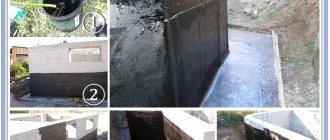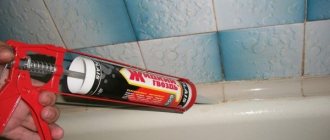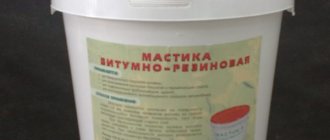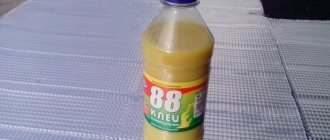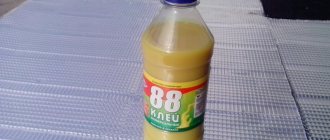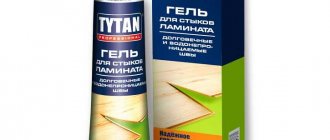This continued exactly until the moment when bitumen-polymer mastic was created. This substance has all the characteristics of bitumen insulation, but is supplied in the form of a viscous, liquid substance, which can be applied by painting the surface to achieve the desired result. After application, bitumen mastic hardens on the surface, penetrates into the pores of the material, ensuring reliable fixation on the surface.
What is included in bitumen mastic
The main element is petroleum bitumen, which looks like a plastic composition of coal-black color. In addition to the main component there are:
- Hardeners (mineral wool, ash, asbestos, brick chips, lime);
- Thickening additives (peat, chalk);
- Fiber filler that increases elasticity and flexibility.
To impart working properties, technical additives are added to the black resin in accordance with the GOST certificate of conformity. They provide resistance to temperature changes, provide elasticity and other important characteristics.
The main element is petroleum bitumen, which looks like a plastic composition of coal-black color.
How to apply mastic?
Both application methods are quite technologically advanced and provide an excellent opportunity to carry out work related to the roofing device, quite simply and quickly, regardless of the angle of inclination of the roofing surface. This is clearly noticeable when installing a roof, which has a huge number of different elements and connections.
When covering pipes, load-bearing structures, shaft roofs, etc., it is necessary to spend a lot of time and effort cutting out rolled material, while mastic makes it possible to make exactly the same even coating, but much easier and faster, which is why mastic prevails over rolled materials.
Manufacturing technology of bitumen-polymer mastic
The first step in preparation is loading pure bitumen into a boiler, in which the mass is heated to 140 degrees. During the cooking process in the boiler, the bitumen melts and dehydrogenates. To speed up the process, a defoamer is added. The next step is to pump the molten bitumen into a mixing apparatus, into which KOSZhK and various additives are sequentially added. After adding each component, the solution is thoroughly mixed for 30 minutes. When all the ingredients are mixed, the material is distributed into oil-lubricated metal containers. After complete cooling, the briquettes are treated with talc and packaged in paper packaging.
During the cooking process in the boiler, the bitumen melts and dehydrogenates.
What is the difference between primer and bitumen mastic?
Based on petroleum construction bitumen, not only waterproofing mastic is made, but also other materials, for example, bitumen primer. These compositions have differences:
- Mastic has a denser and more viscous structure, therefore it is used as the main hydrophobic coating. The primer is more liquid. It is needed to prepare the surface for further waterproofing layers, to fill all the gaps and cracks.
- The primer is used as a binding component in road works and as a protective coating for pipelines. A viscous analogue is often needed to protect surfaces from moisture.
- The primer dries much faster than its viscous counterpart.
Application technology
Bitumen-polymer mastic has always been in demand among builders. This popularity is easily explained by its versatility.
Bitumen-polymer mastic has always been in demand among builders.
Roof protection
The roof must be a strong protection of the room from precipitation. Bitumen-polymer mastic creates a durable moisture-proof film that will protect the house from inclement weather for many years. To create a durable coating, it is recommended to use a curable polymer roofing mastic together with a reinforcing mesh and apply it in 2 layers.
Bitumen-polymer mastic creates a durable moisture-proof film that will protect the house from inclement weather for many years.
Roof repair
If voids have formed in the roof, or the roofing material is moving away from the base, then the damaged area can be repaired in literally an hour. To do this, the damage is thoroughly cleaned and the void is filled with mastic. After the composition is distributed, the area is covered with a patch and the roof again serves its owner.
After the composition is distributed, the area is covered with a patch and the roof again serves its owner.
Sealing
Moisture-proof properties allow bitumen mastic to act as a sealant. 2 different processing methods are used:
- Pouring. The heated material is applied in 1 layer over the entire area and carefully leveled. When the bitumen layer hardens, roofing material is placed on top;
- Coating. The builder applies bitumen to the surface in 2-4 layers, the thickness of each should not be more than 1 mm, and to facilitate the process, it can be treated using aerosol mastic.
Moisture-proof properties allow bitumen mastic to act as a sealant.
For bathrooms
Reliable waterproofing of the bathroom is the key to peace of mind for the residents of the house. It is necessary to treat not only the floor with mastic, but also the joints between the walls and the floor to a height of at least 10 cm. From the bathroom, sink, and sanitaryware, it is also necessary to treat the next half meter.
Reliable waterproofing of the bathroom is the key to peace of mind for the residents of the house.
For floor
To waterproof the floor, mastic is applied in 1 layer and carefully leveled. This coating provides reliable waterproofing, and among many other materials it can easily be called the most budget option with minimal consumption.
To waterproof the floor, mastic is applied in 1 layer and carefully leveled.
For a well made of concrete rings
The joints between concrete rings in a well cannot be called airtight. To prevent water from leaving the well and to prevent dirt from getting into the water, the joints must be treated with mastic. It is environmentally friendly, elastic, forms a good adhesive layer with the base, and even after complete drying, cracks do not form on the surface. The material is applied in 2-3 layers, with each subsequent layer applied only after the previous one has completely dried.
To prevent water from leaving the well and to prevent dirt from getting into the water, the joints must be treated with mastic.
For metal
Bitumen mastic has anti-corrosion and moisture-proof properties, which means it will be an excellent addition to a surface made of metal sheets. It will reliably close the joints and will not allow moisture to pass through, and even prolonged contact with water will not cause rust.
Bitumen mastic has anti-corrosion and moisture-proof properties.
For the foundation
Foundation cracks, joints and waterproofing are important elements to consider when building a house. Due to its elasticity, mastic compensates for the movement of slabs and is a reliable building element. To treat the foundation, bitumen is applied around the perimeter in 2 layers.
Due to its elasticity, mastic compensates for the movement of slabs and is a reliable building element.
Composition and production
The main component of the mastic is modified petroleum bitumen. It also contains latex, mineral fillers, elastomeric and synthetic resins.
Additionally, solvents, various modifiers and additives are introduced that can change the performance properties of the mastic. Thanks to the additives, some of the negative properties of bitumen are neutralized, such as increased fluidity when heated and brittleness in severe frost.
Is it possible to make bitumen mastic with your own hands?
Making your own mastic is within the capabilities of anyone who has the desire to do so. To do this, you will need to stock up on pieces of bitumen, fillers, plasticizers and solvent. Talc, asbestos, sawdust, dolomite or granite dust, chalk and other bulk substances are used as fillers.
Used machine oil can be used as a plasticizer. Solvent - solvent or similar substances. To prepare 10 liters of mastic, you need to take about 9 kg of crushed bitumen, 0.5 liters of oil, 1 kg of any filler, as well as 0.5 liters of solvent.
The process of preparing our mastic should take place in the open air. You can use an ordinary fire. Any metal container is used to kindle bitumen. A barrel or bucket will do. The bitumen is crushed and cooked for about 3 hours. During this time, excess moisture evaporates from it.
A sign of the end of evaporation is the disappearance of foam from the surface of the bitumen. Filler and plasticizer are gradually added to the boiling composition. If necessary, a solvent is also added there. The finished mastic can be stored or used immediately.
Using bitumen mastic for roofing, you can quickly and efficiently seal the surface, without the use of equipment. Mastic can be applied to any cleaned and smooth surface
How to prepare bitumen mastic
The hot type of mastic is produced in several stages. First, the bitumen is heated in special containers at a temperature of no more than 180 degrees. Moisture evaporates from it. Separately, prepare a mixture of fillers and modifiers, which are mixed with bitumen using a dispenser.
Next, plasticizers are added to the composition. Hot mastic is ready. It is used immediately, going to the construction site, or poured into buckets and stored. Preparation of cold mastic has its own characteristics. The process differs in that the bitumen itself is added in doses to the prepared components, preheated to a temperature of 160 degrees.
After mixing, the composition is cooled to 70 degrees, and then the necessary additives and solvents are added to it. The composition is cooled and packaged in briquettes, jars or plastic buckets.
The video shows how you can quickly make bitumen mastic (primer) yourself:
Specifications
The characteristics of individual compositions depend on the components included in it. However, a number of criteria can be identified that accurately characterize bitumen-based mastic:
- Moisture-proof properties;
- The mass penetrates deep into pores and cracks, reliably filling them;
- Protection against corrosion;
- Antifungal effect;
- Wear resistance.
Additional properties of individual mastics are described in more detail on the manufacturer's packaging.
The characteristics of individual compositions depend on the components included in it.
Video description
Here's a short video that should help you find the answer:
It was previously mentioned that the properties of bitumen mastic when waterproofing the foundation allow it to be used even in the presence of rust or contamination. This is true, but it is necessary to understand that comprehensive training, which includes a clean place of work, has a positive effect on service life.
Another point to pay attention to is the attitude of companies towards their employees. If it is good, there is a high chance that this will apply to all aspects of the activity.
Thus, working with bitumen mastic must be carried out in thick clothing specially produced for builders. To avoid damage to the eyeballs from particulate matter and caustic fumes, special glasses are used. If you work with hot mastic, you must use a respirator.
Moreover, safety regulations require that even when working on a simply hot day with high temperatures, no areas of skin are left exposed. Although it cannot be said that only the attitude towards employees is enough to judge the entire company and the results of its activities, the considered nuances are enough for the initial impression.
Employees who are cared for often show better work results Source cs7.pikabu.ru
Recognition of low-quality material
When purchasing something, you want it to be of high quality. By recognizing the problem in advance, you can avoid many undesirable consequences. You don't even need to open the container for this. The point here is that despite its density, mastic is lighter than water. Therefore, a 10-liter bucket cannot possibly contain a substance worth 10 kilograms or even more.
During production, the mastic is poured hot, and it has an increased volume. It is better to avoid all materials that do not meet the required weight values and not allow their use. Otherwise, the created waterproofing will last only a few years. Then you will have to redo it, spending your own time and money. To prevent this, bitumen mastic for waterproofing the foundation must be laid in compliance with technical requirements.
Application: where and when you need bitumen mastic for roofing
It is almost impossible to imagine the construction industry without bitumen mastic. It is used to repair minor cracks, process seams, and is also used for waterproofing foundations. However, bitumen-polymer mastic has received the greatest recognition in the field of roofing work.
It is almost impossible to imagine the construction industry without bitumen mastic.
Installation of mastic roofing
The melted mastic is distributed over the base. During the cooling process, a thin, seamless moisture-proof film is formed over the entire surface area. To give the mastic greater hardness, laying is done using a reinforcing mesh and pouring mastic on top in 2 layers. Also, hot bitumen-polymer mastic is used to lay the roofing membrane.
During the cooling process, a thin, seamless moisture-proof film is formed over the entire surface area.
Roof repair: description of the process in detail
Bitumen is also indispensable for partial repairs of roofing materials. To do this, the damaged area is cut in the shape of a cross. The edges are folded back and mastic is poured inside. Next, the edges are glued to the mastic, using precise movements from the edge to the center. The new patch can be additionally secured with a reinforcing mesh, having previously cleaned the surface to be repaired of rust.
Bitumen is also indispensable for partial repairs of roofing materials.
Advantages ↑
As a waterproofing agent, mastic coating has high performance qualities:
- When the composition is applied correctly, a seamless film is formed on the surface to be treated.
- Due to the high level of adhesion, the rubber-like film does not swell under the influence of negative factors, such as water vapor.
- This material is odorless, it does not contain toxic emissions or substances harmful to health, therefore it is recommended not only for external, but also for internal work.
- Ideally seals joints and seams, glues waterproofing material and even tiles.
- Exceptionally strong and durable - the film formed after applying the mastic can last more than a century.
- The composition is applied to various types of surfaces: concrete, dry or wet, iron, galvanized iron, which allows the use of BPM in the construction and treatment of surfaces of swimming pools or wells.
- This is excellent protection against dampness, mold formation, the appearance and proliferation of fungus and other microorganisms.
The mastic coating is different:
- ductility and elasticity;
- resistance to extreme temperatures and high humidity;
- fast hardening;
- ease of application and use;
- low cost.
General technology and rules of application
Regardless of what material the builder chooses, the algorithm of actions remains identical. First of all, it is necessary to clean the surface from dust, dirt and rust. To ensure better adhesion of the material, the surface is treated with a primer.
Thorough cleaning is also important to ensure even distribution of the bitumen composition.
When working with cold mastic, it must be warmed to room temperature and a solvent added. For hot compounds, the operating temperature reaches 150 degrees. Next, the composition is distributed over the surface using a brush or spatula.
For cold application, sprayers are created that supply the composition under pressure and constantly mix the mass.
When working with cold mastic, it must be warmed to room temperature and a solvent added.
Execution of work ↑
- The composition is applied to a clean, dry surface of concrete or metal. In this case, the moisture content of the concrete screed should not exceed 4%, and there should be no rust on the metal surface.
- Before application, the cold mastic is thoroughly mixed. To obtain the required viscosity, the composition is diluted with a solvent. Suitable for these purposes: solvent, nefras, gasoline, toluene.
- Treatment with the composition is carried out using any rigid painting tool: spatula, brush or roller, or using airless pneumatic spraying technology. It is also possible to pour a bitumen-polymer mastic coating with future leveling; this requires special combs or a mop. The optimal layer thickness is 2 mm. The required thickness is gained in several pours.
Note:
The number of layers can be up to five with interlayer drying of at least one hour. Their number depends on the purpose of the waterproofing.
- Once the stabilization process is finally completed, an elastic, seamless and waterproof layer is formed.
- When using reinforcing material, it must be completely buried (say, using polystyrene foam) in the mastic mass. As a rule, fiberglass, fiberglass or other materials are used for reinforcement.
- The drying time of the applied bitumen polymer layer depends on various factors: its thickness, environmental conditions, and the type of structure being treated. For complete drying, at least 7 days are required.
© 2022 stylekrov.ru
Subtleties and nuances of working with bitumen mastics
The first problem that builders may have when working with mastic is the difficulty of creating a uniform layer over the entire area. Despite the fact that mastic perfectly smooths out holes and cracks and forms a durable coating even vertically, it is important to clean the work area and then level it. Otherwise, water and dirt may accumulate in the formed pits.
The next point that is important to consider is the operating temperature of the composition. If the jar was in a garage or other cold room, then it must first be warmed up. The simplest option would be a water bath, but if you have the appropriate container, the mastic can be melted over a fire. As construction proceeds, the composition may harden and because of this the layer may turn out to be uneven. If work takes place in the summer, then the jar with the composition is left in the sun.
If the jar was in a garage or other cold room, then it must first be warmed up.
Knowing the main characteristics and scope of application, a novice builder can easily choose the appropriate composition and release form for himself in the store.
Classification
Based on the method of application, bitumen-polymer mastic is divided into two types: cold and hot.
- Cold application. Cold-applied bitumen-polymer mastic is the most popular because it does not require preparation or heating, and is immediately ready for use. If necessary, a solvent is added to it to liquefy it. This mixture dries quickly even at temperatures below zero, but has a pungent odor. Water-based mastic dries much slower, but it is environmentally friendly and odorless. Its only drawback is that it can only be stored and applied at above-zero temperatures.
- Hot application. This mastic must first be heated to a temperature of 150-180 degrees, so it can be used even at sub-zero temperatures. After hardening, an elastic, non-porous layer is formed that does not shrink. The hot application method is used less frequently due to the complexity of application and increased energy costs.
Popular brands and their prices
Based on a study of the demand for bitumen waterproofing of different brands and analysis of reviews, a table was compiled with a list of the most popular bitumen waterproofing compounds for roofing.
| Brand | Characteristic | Delivery in buckets weight, kg/cost, rub. | Price per 1 m2, rub. |
| TechnoNIKOL | Cold bitumen-rubber solvent-based | 18 kg/1240 rub. | 103 |
| Aquamast | — « — | 18 kg/1833 | 153 |
| BRIT - roofing | Bitumen-rubber cold application | 30 kg/2300 | 120 |
| MBR-X-65 | — « — | 60 kg/4200 | 105 |
| ISOBOX | — « — | 23 kg/3400 | 210 |
| MBK | Hot bitumen | By weight | 80 |
| Transkor-Gaz | Bitumen-polymer hot | — « — | 140 |
Kinds
Mastic based on petroleum bitumen is a multifunctional product used in many branches of construction. To make the use of this material possible in different conditions, manufacturers produce it in several forms. The following types of rubber bitumen are most often found on sale:
- Hot rubber mastic. Hot mastic is a solid waterproofing agent that is applied by melting. Rubber-bitumen of this type is melted over a fire at a temperature of 170 degrees so that it turns into a liquid state, after which it is applied to the surface to be treated. This type of mastic is characterized by economical consumption and affordable price. However, using it when working with your own hands is problematic, since it is used only at temperatures from +5 degrees, so it requires the use of special equipment.
Ingredients for making hot mastic - Cold mastic. This type of bitumen-based waterproofing material is produced and sold in plastic or metal buckets in liquid form. Immediately after opening the container, it is ready for use, so it is more convenient to use. The consumption and price of cold mastic is higher than hot mastic, so it is used only for spot repairs and for small volumes of work.
Cold mastic
Important! The use of hot mastic is possible only at a temperature of +5 degrees, that is, in the warm season, or if a “warmhouse” is equipped. Cold mastic can be used in any weather conditions; this quality is its advantage.
Let's sum it up
Bituminous mastic is one of the most popular waterproofing materials for flat roofs. This is a mixture of petroleum bitumen and a huge number of additives that improve the properties of the composition.
The main additive is solvents. If they are in the composition, then the bitumen mastic will be liquid in the container at room temperature, if not, then it will be in a solid state.
In addition to solvents, polymers, rubbers, latex, asbestos and other substances are added to bitumen mastic to make it more plastic, elastic, durable, thick, hard and viscous.
Choice
The choice is large. In order not to make mistakes, they receive maximum information about each type of composition, its features, characteristics and properties. Get acquainted with reviews on specialized sites and recommendations of specialists. It is advisable that the recommendations be supported by examples from practice.
The store evaluates the appearance of the packaging and inquires about the expiration date. If everything is satisfactory, a small weighing test is performed. The fact is that a normal product contains components that are lighter than water. In addition, the composition is poured hot at the factory, which means in an expanded state. If a five-liter container weighs 5 kilos or more, then a question arises about quality.
As for do-it-yourself compositions, it is better not to do serious work with them. You shouldn't skimp on this material.
Bituminous waterproofing is a universal and most affordable option to protect the foundation, roof and other elements of the structure from moisture. To extend the service life of brick, reinforced concrete and monolithic structures, and to prevent moisture from entering, and therefore reduce the likelihood of dampness and mold inside the house, the use of waterproofing material is required.
Bitumen waterproofing is a common, simple and inexpensive way to carry out the necessary measures.
The bitumen itself is waterproof and, most importantly, it is completely immune to the damaging effects of moisture.
Low cost of materials is of great importance, ease of use is valued no less: for example, waterproofing a foundation based on bitumen does not require special equipment or professional skills. The ease of use of bitumen waterproofing significantly reduces labor and associated costs.
The nuances of roofing repair
Repair of roofing with bitumen resin is carried out by continuous spraying of waterproofing (the spraying process is described above using a special compressor). In another case, local repair of damaged areas of the roof is done manually.
Roof repair with mastic is carried out as follows:
- the base of the roof is cleaned of debris and dirt with a broom and, if necessary, a vacuum cleaner;
- identify areas requiring local repairs: damaged seams, cracked joints, swollen and burst bubbles;
- Damaged areas are repaired with mastic using a regular spatula;
- if there is a large swelling, then in this area the soft roof is cut crosswise with a knife;
- the edges of the cut are bent to the sides;
- the vacated space is filled with mastic, and the petals are returned to their place;
- the area is again covered with a layer of mastic;
- if long-lasting cracks are detected, the entire area is coated with mastic, covered with a piece of geotextile and covered again with waterproofing;
- repair the roof connections to all vertical surfaces;
- upon completion of local repairs, the entire roof is covered with a single layer of mastic, doing this manually or mechanized.
You can learn more about roof waterproofing repairs here.
Spraying liquid roofing using a mechanized method:
